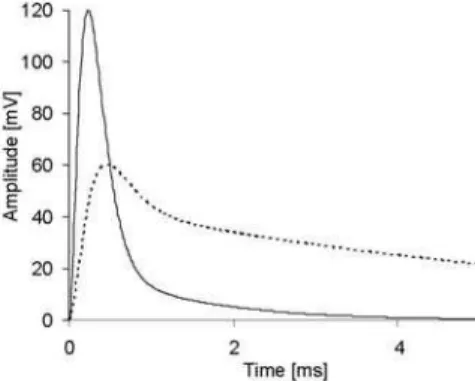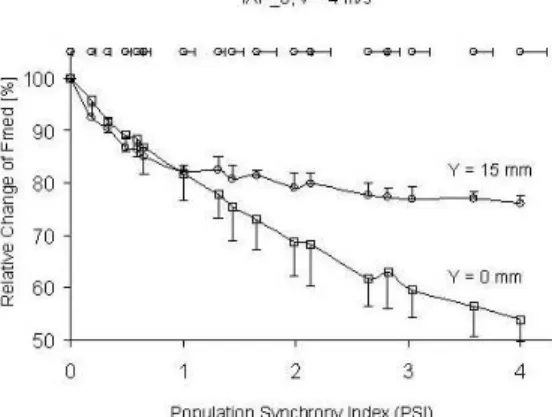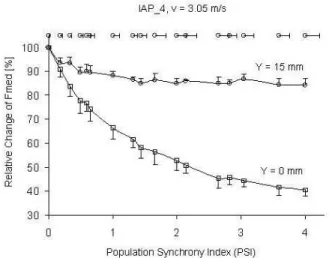Eccentric Contraction-Induced Muscle Fibre Adaptation
Dimitrov V. G.1, Arabadzhiev T. I.2, Dimitrova N. A.2, Dimitrov G. V.2∗
1
Institute of Biophysics, Bulgarian Academy of Sciences 21 Acad. G.Bonchev Str., 1113 Sofia, Bulgaria
2
Centre of Biomedical Engineering, Bulgarian Academy of Sciences 105 Acad. G. Bonchev Str., 1113 Sofia, Bulgaria
E-mail: gvdim@bio.bas.bg
Summary: Hard-strength training induces strength increasing and muscle damage, especially after eccentric contractions. Eccentric contractions also lead to muscle adaptation. Symptoms of damage after repeated bout of the same or similar eccentrically biased exercises are markedly reduced. The mechanism of this repeated bout effect is unknown. Since electromyographic (EMG) power spectra scale to lower frequencies, the adaptation is related to neural adaptation of the central nervous system (CNS) presuming activation of slow-non-fatigable motor units or synchronization of motor unit firing. However, the repeated bout effect is also observed under repeated stimulation, i.e. without participation of the CNS. The aim of this study was to compare the possible effects of changes in intracellular action potential shape and in synchronization of motor units firing on EMG power spectra. To estimate possible degree of the effects of central and peripheral changes, interferent EMG was simulated under different intracellular action potential shapes and different degrees of synchronization of motor unit firing. It was shown that the effect of changes in intracellular action potential shape and muscle fibre propagation velocity (i.e. peripheral factors) on spectral characteristics of EMG signals could be stronger than the effect of synchronization of firing of different motor units (i.e. central factors).
Keywords: Repeated bout, Adaptation, EMG power spectrum, Synchronization
1. INTRODUCTION
It has been well established that a single bout of unfamiliar, predominantly eccentric exercise caused symptoms of muscle damage such as strength loss, pain and tenderness [1-5]. However, eccentric contractions result also in protective adaptation expressed in markedly reduced symptoms of damage after repeated bout of the same or similar eccentrically biased exercises [4-9]. It has been shown that the repeated bout effect can last up to 6 months [10]. The mechanism of this repeated bout effect is unknown.
Some authors attributed the protective effect to neural adaptation [2, 4, 11, 12]. It is hypothesised that an increase in motor unit (MU) activation decreases the mechanical stress per active fibre in the second bout compared with the first one. Changes in motor unit activation between repeated bouts have been examined in humans using surface EMG [3, 9, 12]. It is considered [4] that theoretically an increase in the amplitude of the surface EMG signal relative to torque production in repeated bout would indicate a redistribution of contractile stresses among a greater number of fibres. Such an increase in the amplitude characteristics of surface EMG signal was evident with eccentric strength training [13-15]. However, no change [3, 12] or even decrease [9] has been found in the amplitude characteristics of surface EMG between repeated eccentric bouts. Thus, the hypothesis on participation of greater number of fibres in repeated bout experiments was challenged.
Then, another possible aspect of neural adaptation was also considered, namely, recruitment of more slow-twitch MUs or/and greater motor unit synchronization [4, 9, 11, 12]. They could explain scaling of power spectra of surface electromyographic (EMG) signals to lower frequencies during the repeated bout [9, 12, 16].
Thus, the question arises whether it is possible to have an adaptation at the muscle, i.e. peripheral, level. The aim of the study was to compare the possible effects of changes in IAP profile and in synchronization of different MU firing on power spectra of EMG signals.
2. METHODS
The simulations of interferent EMG signals under changes in motor unit synchronization, and in IAP shape (Fig. 1) and MFPV (4m/s or 3.05m/s) typical for normal and fatigued muscles were described elsewhere [21].
Fig. 1 Shape of IAP for normal (solid line) and fatigue (dotted line) conditions. Only the first 5 ms of the signal durations are shown.
Maximal desynchronization (due to different length of nerve terminals and synaptic delays) for all the fibres was set to 750 µs. A point monopolar recording electrode was located above the longer semi-length, 30 mm away from the middle of the end-plate region. The electrode distance from the muscle axis was 0 or 15 mm for intramuscular and surface EMG detection, respectively. The volume conductor was anisotropic (Kan=5). Median frequencies of intra-muscular and surface EMG signals were calculated for 7 “subjects” that were simulated through 7 random sets of parameters defining the muscle.
3. RESULTS AND DISCUSSION
The synchronization in MU activation leads to reduction of the median frequencies (Figs. 2 and 3). The relative effect of synchron-ization is greater for intramuscular EMG detection (Y=0mm), especially under IAP shape and MFPV typical for fatigue conditions (Fig. 3). However, EMG signals change their frequency content considerably also as a result of the changes in IAP shape and MFPV typical for fatigue conditions. The surface EMG median frequency decreased to 60%, while that for intramuscular EMG to 32% of the values obtained for normal IAP shape and MFPV.
Fig. 2 Relative changes in median frequency (Fmed) with increasing synchronization (PSI) of different MU firing for normal IAP. Different marks are for intramuscular (square, Y=0mm) and surface
Fig. 3 Relative changes in median frequency (Fmed) with increasing synchronization (PSI) of different MU firing for IAP typical for
fatigued muscle. Different marks are for intramuscular (square, Y=0mm) and surface (circle, Y=15mm) EMG detection.
An increase in the duration of MU potentials could explain the differences. MUP becomes wider with an increase in mean distance between the active fibres and electrode (Y=0 mm and Y=15 mm) and with changes in IAP shape (Fig. 1) and MFPV typical for fatigue conditions. Under surface detection mainly used in sport and fitness studies, the relative effect of changes in IAP shape and MFPV can be stronger (~40%) than the effect of possible synchronization in MU firing (less than 25%, see Figs. 2 and 3, Y=15mm). Thus, the decrease in the frequency content of EMG signal during the repeated bout [9, 12, 16] could also be due to peripheral adaptation in muscle fibres.
of resting Ca2+ concentration is larger in fast-glycolytic fibres [30-32].
On the other hand, the increased resting Ca2+ concentration leads to changes in IAP shape and MFPV [33,34]. The result of the present study shows that these changes could explain the decrease in the frequency content of the surface EMG signal in the repeated bout.
4. CONCLUSION
The effect of changes in IAP shape and MFPV can overcome that of synchronization of motor unit firing.
ACKNOWLEDGEMENTS
This work was supported by Bulgarian National Science Fund, Grant 1530/05.
REFERENCES
1. Clarkson P.M., K. Nosaka, B. Braun, Muscle function after exercise-induced muscle damage and rapid adaptation, Med. Sci. Sports Exerc., 1992, 24,512–520.
2. Nosaka K., P.M. Clarkson, Muscle damage following repeated bouts of high force eccentric exercise, Med. Sci. Sports Exerc.,
1995, 27, 1263–1269.
3. McHugh M.P., D.A. Connolly, R.G. Eston, E.J. Gartman, G.W. Gleim, Electromyographic analysis of repeated bouts of eccentric exercise, J. Sports Sci., 2001, 19, 163–170.
4. McHugh M.P., Recent advances in the understanding of the repeated bout effect: the protective effect against muscle damage from a single bout of eccentric exercise, Scand. J. Med. Sci. Sports, 2003, 13, 88–97.
5. Black C.D., K.K. McCully, Muscle injury after repeated bouts of voluntary and electrically stimulated exercise, Med. Sci. Sports Exerc., 2008, 40, 1605–1615.
6. Fridén J., J. Seger, M. Sjöström, B. Ekblom, Adaptive response in human skeletal muscle subjected to prolonged eccentric training, Int. J. Sports Med., 1983, 4, 177–183.
7. Mair J., M. , E. , A. , C. , E.
, C. , C. , B. , Rapid
adaptation to eccentric exercise-induced muscle damage, Int. J. Sports Med., 1995, 16, 352–356.
8. McHugh M.P., D.A. Connolly, R.G. Eston, G.W. Gleim, Exercise-induced muscle damage and potential mechanisms for the repeated bout effect, Sports Med., 1999, 27, 157–170. 9. Chen T.C., Effects of a second bout of maximal eccentric
exercise on muscle damage and electromyographic activity,
Eur. J. Appl. Physiol., 2003, 89, 115–121.
10. Nosaka K., K. Sakamoto, M. Newton, P. Sacco, How long does the protective effect on eccentric exercise-induced muscle damage last? Med. Sci. Sports Exerc.,2001, 33, 1490–1495. 11. McHugh M.P., D.A. Connolly, R.G. Eston, G.W. Gleim,
Exercise-induced muscle damage and potential mechanisms for the repeated bout effect, Sports Med 1999, 27, 157–170. 12. Warren G.L., K.M. Hermann, C.T. Ingalls, M.R. Masselli, R.B.
Armstrong, Decreased EMG median frequency during a second bout of eccentric contractions, Med. Sci. Sports Exerc., 2000, 32, 820–829.
13. Komi P.V., E.R.Buskirk, Effect of eccentric and concentric muscle conditioning on tension and electrical activity of human muscle, Ergonomics, 1972, 15 417–434.
14. Hortobágyi T., J.P. Hill, J.A. Houmard, D.D. Fraser, N.J. Lambert, R.G. Israel, Adaptive responses to muscle lengthening and shortening in humans, J Appl Physiol 1996a, 80, 765–772. 15. Hortobágyi T., J. Barrier, D. Beard, J. Braspennincx, P. Koens,
P. Devita, L. Dempsey, J. Lambert, Greater initial adaptations to submaximal muscle lengthening than maximal shortening, J Appl Physiol 1996b, 81, 1677–1682
16. Howatson G., K.A. van Someren, T, Hortobágyi, Repeated bout effect after maximal eccentric exercise, Int J Sports Med
2007, 28, 557–563.
17. Sacco P., D.A. Jones, The protective effect of damaging eccentric exercise against repeated bouts of exercise in the mouse tibialis anterior muscle, Exp Physiol 1992, 77, 757–760. 18. Nosaka K., M. Newton, P. Sacco, Responses of human elbow
flexor muscles to electrically stimulated forced lengthening exercise, Acta Physiol Scand 2002,174, 137–145.
20. Golden C.L., G.A. Dudley, Strength after bouts of eccentric or concentric actions, Med Sci Sports Exerc 1992, 24, 926–933. 21. Arabadzhiev T.I., V.G. Dimitrov, N.A. Dimitrova, G.V.
Dimitrov, Influence of motor unit synchronization on amplitude characteristics of surface and intramuscularly recorded EMG signals, Eur J Appl Physiol 2009b; DOI 10.1007/s00421-009-1206-3.
22. Everts M.E., T. Lømo, T. Clausen, Changes in K+, Na+ and calcium contents during in vivo stimulation of rat skeletal nuscle, Acta Physiol Scand 1993, 147, 357–368.
23. Chin E.R., D.G. Allen, The role of elevations in intracellular Ca2+ in the development of low frequency fatigue in mouse single muscle fibres, J Physiol (Lond) 1996, 491, 813–824. 24. Chin E.R., C.D. Balnave, D.G. Allen, Role of intracellular
calcium and metabolites in low frequency fatigue in mouse skeletal muscle, Am J Physiol 1997, 272, C550–С559.
25. Williams JH. Contractile apparatus and sarcoplasmic reticulum function: effects of fatigue, recovery and elevated Ca2+. J Appl Physiol 1997, 83, 444–450.
26. Allen D.G., Skeletal muscle function: role of ionic changes in fatigue, damage and disease, Clin Exp Pharmacol Physiol 2004, 31, 485–493.
27. Chin E.R., Role of Ca2+/calmodulin-dependent kinases in skeletal muscle plasticity, J Appl Physiol 2005, 99, 414–423. 28. Allen D.G., G.D. Lamb, H. Westerblad, Skeletal muscle
fatigue: cellular mechanisms, Physiol Rev 2008, 88, 287–332. 29. Bianchi P., A.M. Shanes, Calcium influx in skeletal muscle at
rest, during activity and during potassium contracture, J Gen Physiol 1959, 42, 803–815.
30. Gissel H., T. Clausen, Excitation-induced Ca2+ uptake in rat skeletal muscle, Am J Physiol 1999, 45, R331–R339.
31. Gissel H., T. Clausen, Excitation-induced Ca2+ influx and skeletal muscle damage, Acta Physiol Scand 2001, 171, 327–334.
32. Gissel H., The role of Ca2+ in muscle damage, Ann N Y Acad Sci
2005, 1066, 166–180
33. Ishiko N., M. Sato, The effect of calcium ions on electrical properties of striated muscle fibres, Jap J Physiol 1957, 7, 51–63. 34. Howell J.N., K.W. Snowdowne, Inhibition of tetanus tension by
elevated extracellular calcium concentration, Am J Physiol


